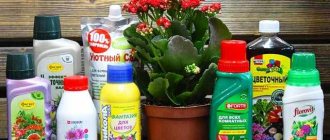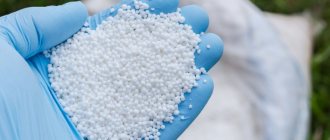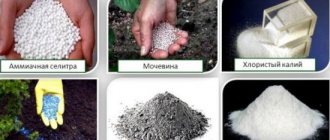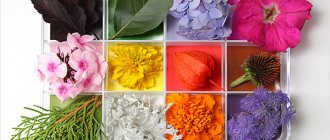Fertilizing garden flowers
If your flowers do not receive the required amount of nutrients, then you should not expect abundant and long-lasting flowering from them, and their appearance will leave much to be desired.
Humic fertilizers
promote rapid rooting of plants, their growth, flowering, increase immunity, improve nutrition, reduce nitrate content in the soil and prevent buds from falling off.
Apply humic fertilizers
in small quantities, because an overdose is dangerous and you will experience the exact opposite effect than you expected. Here it is good to apply the principle that less is more.
Humic fertilizers
obtained from sapropel, peat, oxidized brown coal. In general, humic fertilizer is a nitrogen-containing complex mixture of natural compounds.
For spring tillage, a week before planting flowers on the site, dissolve 3 caps of humate in a bucket of water and water the soil (3 liters of solution per 1 m²). Then cover the soil with a flat cutter and mulch.
Then fertilizing is carried out during the formation of buds on the plants: 1 cap of humate per bucket of water and irrigate the plants with the resulting solution.
Organic fertilizers stimulate the activity of soil microorganisms, such as worms and fungi, which improves soil quality and helps mineralize organic matter. Organic fertilizers, by stimulating the activity of microorganisms and improving the quality and condition of the soil, affect the air and water nutrition of plants.
Organic fertilizers include: manure, peat, green manure, bird droppings, ash, legumes.
Fresh cow dung
It cannot be applied as a fertilizer immediately, it must be passed through the compost, it must rot.
You can make liquid organic fertilizer from cow manure
. To do this, you need to take 1 kg of manure per bucket of water, let it sit for a day and then use it. But you can fertilize with horse manure right away.
To make organic fertilizer from chicken manure
Take 1 kg of chicken manure in a bucket of water and leave to infuse for two weeks. Then, to feed, use 1/2 liter of the resulting slurry per bucket of clean water.
Peat
It perfectly regulates soil moisture, and is also used as a loosening agent for heavy clay soils and as compost along with other types of organic fertilizers.
When adding peat, liming is necessary. With high soil acidity, pH5 and below, 1/2 limestone or chalk is added for every square meter of loamy and clayey soil. Add 0.3 kg of chalk or limestone to sandy soils.
Peat compost:
two months after deoxidation, add cow manure 1:3, mix, cover with straw on top and leave for 4 months. After the expiration date, use it as fertilizer.
Ash
used when planting in holes immediately when planting plants along with compost.
Green manure
Collect, chop, put in a large container, add water and leave to ferment for two weeks, stirring the solution daily. After two weeks, fermentation will end and the plants can be fertilized.
If you made liquid organic fertilizer from nettles
, then before applying it as fertilizer it should be diluted 1:10. Onions, peas and beans cannot be fed with this fertilizer!
Legumes
rich in nitrogen and their aboveground part is a wonderful green fertilizer. The green mass of legumes, after being incorporated into the soil, very quickly mineralizes and fertilizes the area with nitrogen. Lack of nitrogen leads to the fall of buds, the leaves turn yellow and die.
The following flowers do not like organic fertilizers:
tulips, hyacinths, daffodils, asters, nasturtium, marigolds.
The main mineral fertilizers for garden flowers are nitrogen, phosphorus and potassium.
Nitrogen
is responsible for the rich green color of the leaves and stems of the plant. With a lack of nitrogen, chlorosis appears: plant growth slows down. the leaves turn yellow and fall off, the buds die. With an excess of nitrogen, plants bloom poorly and grow very strongly.
Phosphorus
promotes plant growth and development. If there is an overabundance, the lower leaves wrinkle and die, and the plant decreases in size. With a lack of phosphorus, plants bloom later (if they bloom at all) and the leaves acquire brownish-purple spots.
Potassium
Helps resist fungal diseases and restores plant immunity. With a lack of potassium, the shape of the leaves is distorted and brown spots appear along the edges.
Author: Elena Grigorieva AlenKKKa
Copy the article only with an active link to the “Dachnitsa” website and indicate the author of the article.
Reviews from gardeners
One-year-old manure is not yet completely rotted. For pumpkins - cucumbers, watermelons, zucchini, etc. even fresh manure will be a blessing. But for root vegetables I would not rush. As a last resort, I would not dig it up but lay it in the rows, like mulch. When manure gets into the soil (not rotted, then all chemical soil processes do not go correctly)
Sergius
https://otvet.mail.ru/question/166373265
Carrots and beets need poorer soil; do not overdo it with unripe humus (this is manure from last fall). The carrots will be horned and cracked, and the beets will be empty inside and with black spots. In general, root vegetables tend to accumulate nitrates from manure. This also applies to potatoes, they are better in humus. From manure it also grows huge and empty, rots during storage and turns black when cooked.
without GMO
https://otvet.mail.ru/question/166373265
Dry some of the manure, grind it and sprinkle the furrows with carrots... I do this every year... and I don’t regret it... and cucumbers, zucchini and pumpkin can be sown directly in the heap... the harvest will be excellent...
Prankster
https://otvet.mail.ru/question/166373265
Manure as a fertilizer is not suitable for all vegetable crops. Some flowers respond poorly to the application of manure, so before using it on a personal plot, it is worth analyzing what crops will be planted in the beds.
Features of manure fertilizers
In general, manure is a multiphase system consisting of solid, liquid and gaseous substances, and depending on the type of animal husbandry, it can be obtained in three forms:
- bedding-free manure (pure animal waste products, undigested particles of plant food);
- manure with bedding is straw, hay or sawdust, in greater or lesser quantities;
- slurry is, as a rule, manure drains, when not only manure is collected, but also water after washing premises (boxes or milking parlor).
Naturally, manure in its pure form is more profitable to purchase, since it contains only fertilizer.
manure with straw bedding
Straw manure, and even more so manure containing sawdust, has a limited area of application and is less valuable for the gardener. Although, on the other hand, straw in fresh manure absorbs urine and absorbs ammonia, reducing nitrogen losses.
But slurry is not just a highly diluted “nectar”, some of the nutrients of which will simply leak into the ground, but may contain various impurities, such as detergent residues, so when purchasing manure, choose drier fractions.
Advantages and disadvantages
To understand how fertilizer works, it is worth carefully studying the positive and negative aspects of application. Mullein also has pros and cons of using it.
The negative aspects include:
- high consumption of funds. Plus, it can cause excessive oxidative processes and burns;
- Only rotted and fermented manure is suitable for use. And this is always an additional waste of time;
- the animal consumes natural products (grass, hay), which leads to the appearance of seeds and weeds in the mullein.
There are much more positive aspects, which stimulates the desire to use organics:
- additional protection against diseases;
- high yield rates;
- excellent nutrition for plants;
- high digestibility by crops;
- without the presence of nitrates and synthetic fibers;
- fairly low cost;
- You can increase the benefits with additional supplements.
Types of manure
Manure comes in different origins:
- Mullein (from cattle)
- Horse dung
- Pig manure
- Rabbit, bird, etc.
Pig manure, as a rule, is rarely used in vegetable growing and floriculture - it is not readily available, but those who keep pigs can easily use it for feeding. It should be taken into account that pig manure is highly acidic and must be heated for at least a year so as not to burn the plants.
Bird droppings fertilize the soil for up to one year, thereby being the fastest-acting remedy. Used dissolved 1:10.
Mullein is the most common and inexpensive manure; unlike horse manure, it is cheaper and more accessible.
Composition of various types of fresh manure:
- Cow: nitrogen - 0.5%, phosphorus - 0.28%, potassium - 0.6%, lime - 0.4%, pH 8.1
- Horse: nitrogen - 0.59%, phosphorus - 0.26%, potassium - 0.59%, lime - 0.21%, pH 7.9
- Pork: nitrogen - 0.8%, phosphorus - 0.58%, potassium - 0.62%, lime - 0.18%, pH 7.9
In addition, manure contains a number of minerals: sulfur, magnesium, calcium, boron, manganese, cobalt, copper, zinc, molybdenum.
How to use in an open ground garden
In open ground, fertilizer can be used in early spring or late autumn. In this case, the product is used to saturate the soil.
In liquid form, fertilizer is used during the growing season.
It is better to apply liquid fertilizer into special grooves that are dug along the plantings. This way you will protect the plants from drops of fertilizer getting on them. As soon as the product is completely absorbed into the soil, the grooves are filled with earth.
At the same time, do not forget to pre-moisten the soil under the plants. This is necessary so that the manure solution does not burn the roots.
It is very important not to allow the fertilizer to come into contact with the above-ground parts of the plant (stems, leaves).
REFERENCE. Mullein is not used for foliar feeding. Only as a last resort in case of severe nitrogen deficiency. But even in this case, it is better to use other nitrogen fertilizers (urea, ammonia solution).
Cow dung
Cow manure can be purchased at the nearest farm; private traders (from domestic cows) sell manure in buckets or bags. But in general, mullein can be purchased:
- fresh, just removed from a farmstead or farm, it should be of a thick consistency; if not diluted with water from wastewater, it is a non-flowing mass - bedding-free cow manure has the consistency of thick sour cream (humidity 70-75%), and straw - light holds its shape;
- half-rotted - lying in heaps for several months, considerably weathered and having lost 10–30% of the original mass and organic matter. If it was straw manure, then the bulk of the litter has rotted and crumbles easily;
- rotted manure or humus is decomposed manure; the bedding material in it cannot be distinguished either by structure or color from the total mass.
Fresh manure (mullein) is used both in spring and autumn, during the preparation of land for sowing or after harvesting the main crop and incorporating it into the soil. Mullein is first prepared in the form of a solution, diluted with water 1:10 and infused for 5 days. Manure can be used as biofuel when creating warm beds.
Semi-rotted manure can be used to prepare liquid fertilizers and for irrigation: dilute 1 kg per 10 liters of water; as mulch, placing 5-10 cm under the bushes of fruit trees and shrubs.
Rotted manure - ready-made humus is used as a component of the soil mixture for planting indoor flowers (diluted with garden soil 1:3 or 1:4), for preparing the soil in holes when planting (mixed with sand or in pure form), for mulching plantings , bushes and trees.
Application of manure
How to use manure depends on the crop being grown; in general, this fertilizer is suitable for almost all vegetables, fruits and berries. Only some plants accept it in any form, others do not tolerate only fresh manure, but respond well to the addition of humus.
fresh manure with sawdust
Melons (zucchini, cucumbers), as well as cabbage, potatoes and tomatoes are especially responsive to feeding with mullein. Mullein is indispensable for feeding roses, peonies, clematis, dahlias, and lilacs.
Fresh cow manure for fertilizing in root irrigation should be diluted with water in a ratio of 1:10.
Some gardeners use fermented cow slurry (it contains less nitrogen - the ammonia will evaporate). Plastic barrels are used for this. 1/3 of it is filled with manure, the rest is water. The solution must be mixed and left to ferment for a week. The fermented organic fertilizer is ready for fertilizing, but it must be diluted again with water 1:3 (3-4 buckets of water for 1 bucket of slurry). It is good to water berry plants with such fermented slurry - strawberries, raspberries, currants at the rate of 10 liters of fertilizer per 1 m² of land. Fertilizing should be done in the spring, at the time of the appearance of the first young leaves.
How to measure manure:
A standard 10 liter bucket filled to the top can hold:
- 8 kg of fresh horse manure;
- 9 kg fresh cow dung;
- 5 kg of manure on a bed of sawdust or straw
- 7 kg of humus;
- 12 kg of slurry.
What plants don't like fresh manure?
Fresh manure should not be applied to vegetables such as carrots and onions; legumes, beets, garlic, radishes, and radishes do not tolerate it well. But it is impossible to completely do without organic matter in growing these vegetables - manure is applied to the ground in the fall in a rotted form (humus).
What plants don't like mullein?
Not all crops respond well to feeding with fresh, half-rotted or rotted mullein. Adding organic matter to the following plants is not recommended:
- After applying manure, legumes (beans, peas, beans) actively increase their green mass, flowering and fruit ripening slow down.
- Types of cabbage: Chinese and kohlrabi grow with voids inside and become tough.
- Root vegetables (except beets) become tough.
- Onions and garlic do not accept fresh infusion; they grow very weakly and are susceptible to diseases.
- Radish and daikon fruits become deformed and lose their taste properties.
The advantages and disadvantages of organic fertilizers are known to many summer residents. And how much debate is going on on the topic of fertilizing. Cow manure is a universal natural remedy for the garden. Mullein can be used to obtain valuable fertilizer through processing.











